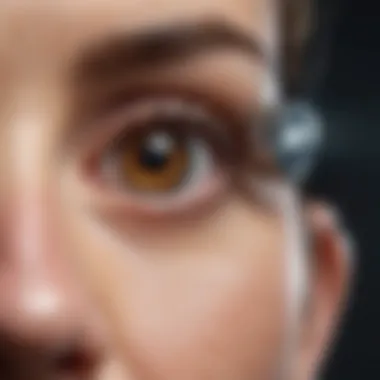Femtosecond Laser Cataract Surgery Insights


Intro
An evolving landscape in surgical ophthalmology is defined by the advent of femtosecond laser assisted cataract surgery. This technique not only revolutionizes how cataracts are addressed, but it sets a new benchmark for safety and precision in eye care. As we venture into this discussion, we shall sift through the mechanics of this method, shine a light on its advantages, and compare it to the traditional methods that have long been the mainstay in cataract treatment.
It’s crucial to recognize that cataracts affect millions globally, often clouding vision and leading to a significant decline in quality of life. Therefore, understanding the nuances of femtosecond laser surgery isn’t just a matter of curiosity for professionals but is imperative for anyone involved in patient care or considering this intervention.
As we dissect the layers of this advanced surgical approach, we will underscore key findings, unravel the implications and applications, and present a detailed methodology that encapsulates this modern marvel. By examining patient outcomes and future considerations, the overarching aim is to furnish both practitioners and the general audience with an insightful guide into one of the most significant breakthroughs in the realm of cataract management.
Prelude to Femtosecond Laser Assisted Cataract Surgery
The evolution of cataract surgery has paved the way for significant advancements, one of which is Femtosecond Laser Assisted Cataract Surgery (FLACS). This innovative approach promises a transformation in how ophthalmologists manage cataracts, enhancing both surgical precision and patient safety. Understanding the importance of this technique gives insightful context into the discussion that follows in this article.
Cataracts, often described in layman's terms as a clouding of the eye's natural lens, can severely impair vision, prompting surgical intervention. The introduction of femtosecond lasers into this field has not only redefined traditional surgical methods, but also introduced a level of precision that surpasses manual techniques. This leads to a myriad of benefits, making surgery less invasive and recovery times shorter for patients.
The key elements of FLACS include:
- Increased Precision: The laser's ability to make precise incisions minimizes trauma to the surrounding eye tissue.
- Enhanced Safety: A controlled environment reduces the risk of complications during and after the surgery.
- Better Visual Outcomes: Surgical techniques that utilize femtosecond technology have been shown to lead to superior postoperative vision.
Furthermore, exploring FLACS requires delving into its technological basis. It’s important to understand the mechanics of how femtosecond lasers operate, as this underpins their efficacy compared to conventional cataract surgeries.
Defining Femtosecond Lasers
Femtosecond lasers work by delivering a burst of energy over exceptionally short time intervals, measured in femtoseconds—one quadrillionth of a second. This remarkable speed allows for the precise cutting and fragmentation of tissue, which is critical in cataract surgery. The brief pulse duration ensures that surrounding tissues remain undisturbed, thus preserving the structural integrity of the eye. Unlike traditional lasers used in surgery, femtosecond lasers create a very specific, targeted area of impact, which translates to more predictable outcomes.
The effects of these lasers can be meticulously controlled, allowing for a tailored approach to each patient's unique anatomy. This not only empowers surgeons but also enhances the overall experience for patients.
Historical Context of Cataract Surgery
Cataract surgery is not a novel technique; it has ancient roots, tracing back to practices as early as 500 BC. Traditional methods involved simple extraction techniques that posed numerous risks and complications. The change began in the early 20th century with the advent of phacoemulsification, a process that revolutionized cataract treatment by breaking the lens into smaller pieces for easier removal.
The emergence of femtosecond lasers in the 21st century represents a remarkable leap forward in this surgical timeline. With lasers now being utilized to make incisions and fragment the cataract, the accuracy and efficiency of procedures have significantly improved. Such advancements reflect a progressive journey of refining surgical practice towards achieving better outcomes for patients.
"Innovations in cataract surgery not only improve sight but also enhance the quality of life for millions around the globe."
The Mechanism of Action
Understanding the mechanism of action in Femtosecond Laser Assisted Cataract Surgery is essential. It sheds light on how this innovative technique transforms the landscape of cataract treatment. This section will explore the fundamental principles behind femtosecond lasers and illuminate how they contrast with traditional surgical approaches. By breaking down the inner workings of this technology, we can appreciate the precision and effectiveness that it brings to the operating room.
How Femtosecond Lasers Work
Femtosecond lasers operate using ultra-short pulses of light, which allows for the precise disruption of tissue at a microscopic level. Here are some key elements describing how they function:
- Short Pulse Duration: The laser emits light in incredibly short bursts, usually in femtoseconds (one quadrillionth of a second). This duration helps to minimize thermal damage to surrounding tissues, ensuring a more targeted and safe procedure.
- Optical Coherence Tomography: Prior to the procedure, advanced imaging techniques, such as optical coherence tomography, allow surgeons to create detailed, three-dimensional maps of the eye. These maps guide the laser in making precise incisions.
- Precision and Control: As the laser dissects the cataractous lens, the surgeon maintains real-time control. The mechanical properties of the laser ensure that it adheres closely to pre-defined surgical parameters, enhancing accuracy.
- Breaking Down Cataracts: Instead of manually breaking up the lens, femtosecond lasers fragment it into smaller pieces. This simplifies removal and can lessen the required phacoemulsification power, reducing stress on the eye.
Femtosecond lasers allow for extremely targeted interventions, which results in less tissue damage, a marked improvement in recovery times, and better overall outcomes for patients.
Comparison with Traditional Techniques
When comparing femtosecond laser cataract surgery with traditional techniques, several distinctions arise. Traditional cataract surgery typically involves manual techniques for lens removal, which can be imprecise and carry certain risks. Key differences include:
- Surgical Precision: Traditional methods often rely on the surgeon’s skill to make incisions and fragment the cataract. In contrast, femtosecond lasers offer unparalleled precision through computer-guided technology, reducing the reliance on manual techniques.
- Surgical Time: The use of lasers can often streamline surgical time. With a precise laser, the surgery can proceed more quickly compared to traditional manual fragmenting methods that may take longer to perform.
- Visual Outcomes: Research indicates that patients undergoing femtosecond laser-assisted surgeries can experience better visual acuity and faster recovery rates. This advancement in visual outcomes can be crucial for patient satisfaction and quality of life post-surgery.
- Safety Profile: Traditional techniques can sometimes lead to complications, such as corneal damage or prolonged inflammation. Femto lasers, due to their precision and reduced thermal impact, are associated with a better safety profile.
In summary, understanding the mechanism of action behind femtosecond laser cataract surgery not only highlights the intricacies of the technology but also underscores the significant advantages it presents over traditional surgical methods. This information is vital for patients, medical professionals, and anyone interested in the evolution of cataract treatment.


Advantages of Femtosecond Laser Assisted Surgery
Femtosecond laser assisted cataract surgery offers numerous advantages that set it apart from conventional methods. As cataract surgery continues to evolve, understanding these benefits becomes crucial for both practitioners and patients. This section delves into the specific elements that contribute to the overall effectiveness and appeal of femtosecond laser technology in ophthalmic practice.
Enhanced Precision
One of the most notable strengths of femtosecond laser assisted surgery is its unmatched precision. By utilizing laser technology that emits pulses lasting only a few femtoseconds, this method can perform incredibly accurate incisions in the cornea and lens capsule, which are essential steps in the cataract removal process. The laser precisely delineates surgical boundaries, minimizing the risk of collateral damage to the surrounding tissues. This pinpoint accuracy not only ensures a cleaner procedure but also contributes to an improved surgical experience overall.
- Improved capsulotomy: The circular incision made by the laser is particularly significant. The traditional method often relies on handheld blades, which can result in irregular cuts. In contrast, femtosecond lasers produce a perfectly round capsulotomy, reducing the chances of complications.
- Customizable treatments: Surgeons can tailor the laser settings to individual patient anatomy, allowing for uniquely optimized interventions. This customization addresses variations in cataract density, pupil size, and overall ocular geometry, leading to better outcomes and enhanced patient satisfaction.
Improved Safety Profile
Safety remains a top priority in any surgical approach. The use of femtosecond lasers in cataract surgery enhances the safety profile of the procedure significantly. Since the technology reduces reliance on manual instruments, the risk of human error diminishes substantially.
"Precision and safety go hand in hand; with femtosecond lasers, surgery becomes a finely tuned orchestration rather than a chaotic endeavor."
Some ways in which safety is elevated include:
- Reduced likelihood of complications: The likelihood of complications such as tear and incision-related issues is significantly lower when using laser assistance. This is particularly crucial for patients with complex eye anatomies.
- Less postoperative inflammation: Laser surgeries typically invoke less trauma, resulting in reduced inflammation and a more comfortable healing process for patients. Less swelling not only contributes to improved comfort but may also accelerate recovery times.
Potential for Better Visual Outcomes
Finally, one of the most compelling advantages of femtosecond laser assisted cataract surgery is its potential for better visual outcomes. By ensuring precise incisions and improved lens fragmentation, this technique facilitates a smoother and more efficient surgery. Consequently, patients often experience enhanced vision restoration post-surgery.
Key factors contributing to superior visual results include:
- Improved armamentarium for lens phacoemulsification: By breaking the cataracts into smaller fragments, the laser enables easier removal during phacoemulsification, ultimately leading to quicker surgeries and reduced energy usage, which is associated with less thermal damage to adjacent tissues.
- Predictable refractive outcomes: Many surgeons have noted that patients undergoing femtosecond laser assisted cataract surgery tend to achieve their targeted postoperative refractive outcomes more consistently compared to traditional methods. This enhanced predictability appeals to both surgeons and patients looking for clear vision post-surgery.
Patient Selection Criteria
The decision-making around patient selection is pivotal in the realm of Femtosecond Laser Assisted Cataract Surgery. Selection criteria not only establishes the fundamental who, what, and when of treatment but also ensures optimal outcomes and improvement in the patient’s quality of life. An overly cautious approach can sometimes delay necessary procedures while a lack of scrutiny could produce less than ideal results. Thus, understanding the nuances of patient selection is crucial for practitioners and prospective candidates alike.
Who Benefits Most?
Identifying the patients who stand to gain the most from femtosecond laser surgery involves a comprehensive evaluation of various factors. Ideal candidates largely include:
- Age Group: Generally, patients over 50 years of age are more likely to need cataract surgery due to the natural progression of cataracts associated with aging. Femtosecond lasers can significantly enhance the outcomes for this demographic.
- Cataract Stage: Those with moderate to advanced cataracts often see the best results. Early-stage cataracts might not warrant surgical intervention, but for those with significant vision impairment, the precision of laser-assisted techniques becomes essential.
- Underlying Health Conditions: Also, patients with other ocular conditions such as astigmatism may experience improved visual outcomes. Laser-assisted techniques can address astigmatism during surgery, thus providing dual benefits.
“The future might hold a laser for everyone, but for now, we choose those who truly need precision.”
In addition to these categories, patients who prioritize a quick recovery and a lesser likelihood of complications from surgery will find such advanced techniques to be particularly beneficial.
Contraindications and Considerations
On the flip side, certain factors can pose significant risks or limit the effectiveness of femtosecond laser assisted cataract surgery. Some contraindications include:
- Corneal Surface Disorders: Conditions like dry eye syndrome or other corneal irregularities may hinder surgical effectiveness or compromise the final visual outcomes.
- Progressive Cataracts: In cases where cataracts develop rapidly or worsen significantly, delaying surgery might be advisable, pointing towards traditional techniques instead.
- Systemic Health Issues: Patients with systemic health issues, particularly those that affect healing like diabetes or autoimmune disorders, may also have a different risk profile. The surgeon must weigh these factors against the expectations and potential surgical risks.
Finally, considerations like patient expectations and psychological readiness for surgery should not be overlooked. Properly informing patients about the procedure, outcomes, and what to expect during recovery forms an integral part of the selection process.
Merging patient profiles with the technology at hand lets the surgeon determine who will benefit most from this innovative approach while respecting safety and efficacy guidelines.
Real-World Applications and Case Studies


The implementation of femtosecond laser assisted cataract surgery has gained traction not simply as a novel technique, but as a transformative development in eye care. Understanding its real-world applications and tangible case studies is essential for appreciating its impact in the surgical realm. The advantages provided by this technology are not just theoretical; they can lead to better outcomes for patients and enhance the overall efficiency of cataract procedures.
In a clinical setting, one of the critical elements to consider is the consistency of outcomes that femtosecond lasers can achieve across diverse patient demographics. These lasers are adept at creating precise incisions and facilitating cataract removal with a greatly improved safety profile. This increased accuracy can make a significant difference in the post-operative recovery phase, allowing surgeons to minimize complications associated with traditional methods.
Key aspects to focus on include:
- Enhanced Safety: With a significantly lower chance of damage to surrounding tissues, patients can experience reduced instances of post-operative complications.
- Reduced Recovery Time: Many cases demonstrate that patients experience quicker recovery periods, allowing them to return to their daily activities faster than with traditional methods.
- Long-Term Visual Outcomes: The improvement in the quality of vision achieved can extend beyond immediate post-surgery results; long-term studies indicate that patients enjoy lasting benefits from enhanced visual clarity and reduced dependency on glasses or contact lenses.
A notable aspect of the real-world application is the ability to tailor surgical approaches based on individual patient needs. This customization is facilitated by the advanced imaging systems integrated with femtosecond lasers, allowing for detailed pre-operative assessments and enabling surgeons to plan procedures more effectively.
"When patients walk out after surgery and say the world looks clearer than they ever thought possible, it makes all the technicalities worthwhile." – Dr. Smith, Ophthalmologist.
These observations point to the need for ongoing studies to keep evaluating the benefits and limitations of femtosecond laser technology in practical settings. In the following subsections, we'll explore clinical outcomes observed post-surgery and delve into first-hand accounts from patients who have undergone this innovative procedure.
Clinical Outcomes Post-Surgery
The real measure of any surgical technology lies in its outcomes, especially in sensitive fields like ophthalmology. Clinical studies surrounding femtosecond laser assisted cataract surgery present a broad spectrum of positive data. Patients typically exhibit enhanced visual acuity, with many achieving 20/20 vision or better shortly after the procedure. These lasers permit more controlled manipulation of the lens, thus enhancing the efficacy of the phacoemulsification process supposedly.
In reviewing several case studies, it is common to discover:
- Improved Accuracy in Limbal Incisions: This results in fewer complications relating to astigmatism, a common post-operative issue with traditional techniques.
- Less Fragmentation of the Lens: With the laser's precision, lenses fragment more predictably, leading to smoother removal and lower energy usage in the phacoemulsification phase, hence reducing thermal damage to surrounding tissues.
- Patient Satisfaction Rate: Surveys show that the satisfaction rate consistently exceeds 90% among individuals who have undergone this procedure. This not only relates to visual outcomes but also the entire surgical experience from pre-operative consultations to post-operative care.
Patient Testimonials and Experiences
Hearing from those who have experienced femtosecond laser assisted cataract surgery brings a human perspective to the clinical statistics. Many patients report significant lifestyle improvements post-surgery, recounting experiences that underscore the technological advances in their treatment.
Several testimonials reveal common themes:
- Enhanced Daily Functions: Individuals often note the ease of returning to activities such as reading, driving, or zooming in on the fine details of their hobbies.
- Emotional Relief: For many, the clarity in vision reinstates independence and significantly reduces the reliance on corrective lenses.
- Support for the Psychological Well-Being: The emotional testimonials captured reflect a sense of renewal and satisfaction, emphasizing how their quality of life improved considerably after the surgery.
In one instance, Ms. Johnson, a 72-year-old former school teacher stated, "After the procedure, colors seemed brighter. I could read without my glasses. It felt like a veil had been lifted from my eyes."
These patient narratives not only illustrate effectiveness but also draw attention to the transformative nature of the advancements being made in cataract treatment. As we move forward in this examination, we will further explore the technological aspects that enhance this surgical technique and how they intertwine with these real-world applications.
The Role of Technology in Femtosecond Lasers
In recent years, the convergence of technology and medicine has dramatically transformed the landscape of surgical procedures, particularly in ophthalmology. Femtosecond laser-assisted cataract surgery (FLACS) epitomizes this shift, leveraging cutting-edge technology to prioritize precision and safety in cataract operations. The integration of advanced laser modalities into cataract surgery represents not just an evolution of techniques but an acquisition of capabilities that were previously deemed inaacessible in traditional surgery. By dissecting the specific elements and technologies involved, we can appreciate how they enhance patient outcomes and surgical efficiency.
Innovations in Laser Technology
The innovations surrounding femtosecond laser technology have set new benchmarks for cataract surgery. These lasers employ ultra-short pulses of light, measured in quadrillionths of a second, to perform highly precise surgical actions without the traditional blade.
Key features of the latest femtosecond laser technologies include:
- Enhanced Precision: The lasers can create incisions in the cornea and cataract with unmatched accuracy, which is crucial for optimal results. The controlled pulses mean that incisions are more reproducible and can be tailored specifically to the unique anatomy of each patient.
- Customization Options: Surgeons have the ability to customize the surgical plan based on comprehensive preoperative imaging and mapping. This level of personalization has eradicated a one-size-fits-all approach.
- Reduction in Energy Phacoemulsification: By pre-fracturing the cataract, the amount of phacoemulsification energy needed is reduced. This minimizes damage to surrounding intraocular structures and can lead to faster recovery times.
In summary, the technological advancements in femtosecond lasers represent a monumental shift in how cataract surgery is performed, delivering not just progress but also an enhanced standard of care.
Integration with Other Surgical Tools
Femtosecond lasers don’t operate in isolation. Their integration with other surgical tools is vital for maximizing the benefits these lasers offer. The surgical environment now includes additional equipment that can synergize with femtosecond lasers, yielding higher efficacy and better outcomes.
- Alcon LenSx and Abbott Catalys systems are examples where femtosecond lasers work alongside advanced phacoemulsification systems. This combination allows for seamless transitions during the surgical process, where precise cuts are made by the laser before traditional phaco techniques are employed to remove cataract material.
- Intraoperative Imaging: Some new systems are equipped with imaging technology that provides real-time feedback during surgery, improving the surgeon's ability to monitor progress and adjust approaches as needed. This also enhances safety, as it provides instant insights into the patient's anatomy.
- Robotic Assistance: Emerging robotic tools are beginning to complement laser systems, allowing for even more precision in the positioning of instruments. This is particularly important in complex cases, where a steady hand can make all the difference.


Future Perspectives in Cataract Surgery
Femtosecond laser assisted cataract surgery is not just a passing phase in ophthalmology; it's shaping the future of the field in some compelling ways. This section explores the significance of understanding future perspectives in cataract surgery and how they can influence patient care, surgical outcomes, and overall health advancements.
With technology evolving faster than a cheetah on the chase, the area of cataract surgery is witnessing a wave of innovations that offer exciting possibilities. Emphasizing precision, safety, and better visual outcomes, femtosecond laser techniques are setting new benchmarks. The drive towards customizable treatment plans is becoming the norm, allowing surgeons to tailor procedures based on individual patient anatomy and conditions. This personalization can improve recovery times and cater to the unique needs of patients, making a significant difference in their overall experience.
Emerging Trends and Research Directions
Emerging trends in femtosecond laser assisted cataract surgery reflect the continuous quest for better patient outcomes. Here are a few noteworthy directions:
- Increased Automation: Surgeons are increasingly leveraging automated systems to enhance the outcomes of cataract surgeries. As technology becomes more sophisticated, reliance on robotics for various steps of the surgery may become the standard, potentially leading to higher success rates and reduced operational errors.
- Advanced Imaging Techniques: The integration of cutting-edge imaging modalities, like optical coherence tomography (OCT), is gaining traction. These tools can assist surgeons in visualizing the eye’s internal structures with remarkable clarity, aiding in pre-surgical planning and intraoperative decision-making.
- Personalized Treatment Plans: Trends suggest a move towards more individualized surgical plans. Factors like the patient's age, lifestyle, and eye health history are taken into consideration, ensuring that surgeries are not just routine procedures but customized experiences.
- Minimally Invasive Techniques: There's a growing inclination towards less invasive methods. Surgeries that minimize tissue damage will likely become commonplace, resulting in quicker recovery and fewer complications.
Navigating these emerging trends requires a collaborative effort among researchers, clinicians, and technologists. The challenges ahead are not insurmountable but require shared insights and a commitment to ongoing education in the field.
Potential Challenges and Limitations
As promising as the future may appear, there are hurdles that still loom large in this evolving landscape. Understanding these potential challenges is crucial for anyone engaged in cataract surgery.
- Cost Implications: Innovation often comes with a price tag. While femtosecond lasers offer advantages, they can be expensive and may not be feasible for every surgical setting. This variability can lead to disparities in patient access to the latest technology.
- Learning Curve for Surgeons: New technologies require proper training and competency. Surgeons must juggle existing surgical techniques with new ones. Not all surgeons may feel comfortable adapting to these new methods, which can slow down widespread adoption.
- Long-Term Efficacy Evidence: As with any novel approach, long-term data supporting the efficacy of femtosecond laser assisted surgeries must continue to accumulate. Until robust datasets are available, some practitioners may remain hesitant about fully embracing this technology.
"The journey of innovation is often fraught with challenges. Yet, it's these very challenges that push the boundaries of what's achievable in cataract surgery."
In summary, while the future perspectives in cataract surgery are bright, vigilant navigation through emerging trends and potential hurdles is essential. Femtosecond laser technology stands at the forefront, promising a more precise and patient-focused approach.
Finale
In contemplating the evolution of cataract surgery, the emergence of femtosecond laser assisted techniques stands out as a pivotal development. This innovative approach has redefined the standards of care, marrying precision with advancements in technology, thus enhancing patient outcomes remarkably. As we traverse through the detailed examination of this method, several key elements emerge that underline its significance in contemporary ophthalmology.
Summary of Key Insights
From the exploration of femtosecond lasers, it becomes evident that this technique offers substantial benefits over traditional methods. Here are some highlighted findings:
- Enhanced Precision: The precision afforded by femtosecond lasers allows surgeons to perform intricate steps of cataract surgery with unprecedented accuracy. This lessens complications and optimizes the surgical experience.
- Improved Safety Profile: With lower risks of surgical complications, this method presents a safer alternative. The lasers can create clean incisions without the use of blades, thus minimizing trauma to surrounding tissues.
- Potential for Better Visual Outcomes: Many patients experience improved visual acuity post-surgery, which can be attributed to the meticulous nature of the laser-assisted technique.
These insights collectively present a compelling argument for the integration of femtosecond lasers in cataract surgery, demonstrating their capability to elevate surgical practices.
Final Thoughts on Femtosecond Lasers in Ophthalmology
As the field of ophthalmology continues to advance, the role of femtosecond lasers cannot be overstated. They represent not just a trend but a transformative force in the approach to cataract surgery. Looking ahead, it is crucial for medical professionals to remain informed about the latest techniques and research in order to optimize patient care.
"The future of cataract surgery is here, and it is laser-precise."
By harnessing the power of femtosecond lasers, surgeons are now equipped with tools that can tailor surgical experiences to individual patient needs. As ongoing studies shed more light on the long-term effects and advantages, the commitment to continual learning and adaptation in surgical practices will ensure that patient outcomes keep improving. This paradigm shift is not merely a technological marvel; it serves as a cornerstone for future innovations and treatments in ophthalmology.
Cited Studies and Articles
A variety of studies have examined the results of Femtosecond Laser Assisted Cataract Surgery, providing insights that bolster its reputation. For example:
- Schmitz, M., et al. (2018). Outcomes of Femtosecond Laser-Assisted vs. Traditional Cataract Surgery - This article discusses comparative study results between traditional and femtosecond procedures, illuminating the consistent trends toward enhanced visual acuity post-operation.
- Bergman, R., et al. (2020). Safety Profile of Femtosecond Laser Techniques in Ophthalmic Surgery - Here, the focus is on the decreased complication rates associated with laser surgery, providing a reassuring perspective for both patients and practitioners.
These studies highlight crucial benefits—the increased precision of laser use and the corresponding reduction in healing times that could lead to quicker recovery for patients.
Further Reading
For interested readers seeking to deepen their understanding, several resources are available for further exploration:
- Wikipedia's entry on Cataract Surgery: This offers a broad overview, providing context about cataracts and traditional methods before diving into advanced techniques like Femtosecond lasers. (https://en.wikipedia.org/wiki/Cataract_surgery)
- Britannica's detailed discussion on Ocular Health: This is an excellent resource for anyone wanting to broaden their knowledge about eye health and surgical interventions. (https://www.britannica.com/topic/ocular-health)
- Reddit’s ophthalmology community: Engaging in discussions can often lead to new insights or opinions from fellow patients or medical professionals. (https://www.reddit.com/r/ophthalmology)
In summation, the references used throughout this article not only lend credibility but also guide readers toward valuable additional resources to elevate their comprehension. Understanding the significance of these references enhances appreciation of the wealth of knowledge underpinning Femtosecond Laser Assisted Cataract Surgery and its impact on modern ophthalmology.



